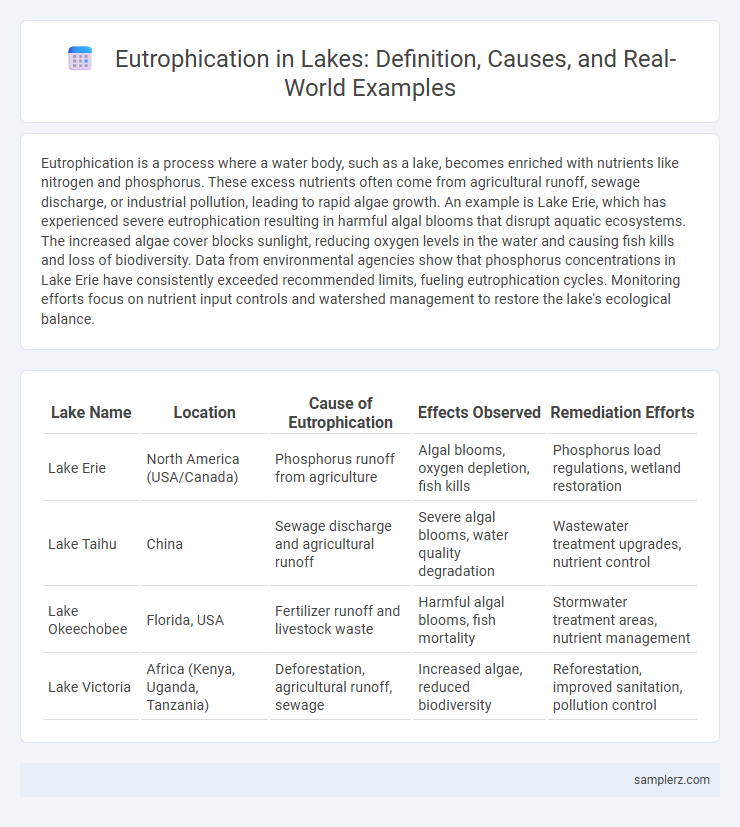Eutrophication is a process where a water body, such as a lake, becomes enriched with nutrients like nitrogen and phosphorus. These excess nutrients often come from agricultural runoff, sewage discharge, or industrial pollution, leading to rapid algae growth. An example is Lake Erie, which has experienced severe eutrophication resulting in harmful algal blooms that disrupt aquatic ecosystems. The increased algae cover blocks sunlight, reducing oxygen levels in the water and causing fish kills and loss of biodiversity. Data from environmental agencies show that phosphorus concentrations in Lake Erie have consistently exceeded recommended limits, fueling eutrophication cycles. Monitoring efforts focus on nutrient input controls and watershed management to restore the lake's ecological balance.
Table of Comparison
| Lake Name | Location | Cause of Eutrophication | Effects Observed | Remediation Efforts |
|---|---|---|---|---|
| Lake Erie | North America (USA/Canada) | Phosphorus runoff from agriculture | Algal blooms, oxygen depletion, fish kills | Phosphorus load regulations, wetland restoration |
| Lake Taihu | China | Sewage discharge and agricultural runoff | Severe algal blooms, water quality degradation | Wastewater treatment upgrades, nutrient control |
| Lake Okeechobee | Florida, USA | Fertilizer runoff and livestock waste | Harmful algal blooms, fish mortality | Stormwater treatment areas, nutrient management |
| Lake Victoria | Africa (Kenya, Uganda, Tanzania) | Deforestation, agricultural runoff, sewage | Increased algae, reduced biodiversity | Reforestation, improved sanitation, pollution control |
Understanding Eutrophication in Lakes
Eutrophication in lakes occurs when excessive nutrients, primarily nitrogen and phosphorus from agricultural runoff or wastewater, stimulate dense algae blooms that deplete oxygen levels. This oxygen depletion harms aquatic life, disrupts ecosystems, and leads to dead zones where fish and other organisms cannot survive. Monitoring nutrient sources and implementing sustainable land management practices are critical to preventing eutrophication and preserving lake health.
Causes of Eutrophication: Key Contributors
Excessive nutrient loading, primarily from agricultural runoff containing nitrogen and phosphorus fertilizers, is a chief cause of eutrophication in lakes. Urban wastewater discharge and industrial effluents also contribute significant amounts of organic matter and nutrients, accelerating algal blooms. These key contributors disrupt aquatic ecosystems by depleting oxygen levels, leading to biodiversity loss and water quality deterioration.
Recognizing the Signs of Eutrophication
Recognizing the signs of eutrophication in lakes involves observing excessive algae blooms that reduce water clarity and oxygen levels. The presence of dense green or blue-green algae mats, foul odors, and dead fish along shorelines indicate nutrient overload, primarily from phosphorus and nitrogen runoff. Monitoring these symptoms helps identify eutrophication early, preventing long-term ecological damage.
Notable Case Studies: Eutrophication in Major Lakes
Lake Erie, one of the Great Lakes in North America, experienced severe eutrophication in the 1960s due to excessive phosphorus runoff from agricultural and industrial sources, leading to massive algal blooms and oxygen depletion. Lake Taihu in China faces recurrent cyanobacterial blooms driven by nutrient pollution from urbanization and agriculture, severely impacting water quality and local fisheries. Lake Victoria in East Africa shows significant eutrophication symptoms linked to increased nutrient loading from surrounding agricultural activities, threatening biodiversity and water supply sustainability.
Lake Erie: A Classic Example of Eutrophication
Lake Erie exemplifies eutrophication, experiencing excessive nutrient pollution primarily from agricultural runoff rich in phosphorus and nitrogen. This nutrient overload triggers dense algal blooms, which deplete oxygen levels and cause widespread fish kills, disrupting the lake's aquatic ecosystem. Efforts to reduce nutrient inputs have been critical in managing algal growth and restoring water quality in Lake Erie.
Impacts of Eutrophication on Aquatic Ecosystems
Eutrophication in lakes, such as Lake Erie, leads to excessive nutrient runoff primarily from agricultural fertilizers, triggering harmful algal blooms that deplete oxygen levels in the water. This hypoxic environment causes massive fish kills, disrupts aquatic food webs, and reduces biodiversity, significantly impairing ecosystem health. Sediment accumulation from decaying algae further alters habitat structure, hindering the recovery of native species and water quality.
Human Activities Driving Eutrophication in Lakes
Agricultural runoff rich in nitrogen and phosphorus is a primary human activity driving eutrophication in lakes, causing excessive nutrient loading that stimulates harmful algal blooms. Wastewater discharge from urban areas introduces organic matter and nutrients, further accelerating oxygen depletion in aquatic ecosystems. Deforestation and land development increase soil erosion, contributing to sediment and nutrient influx that exacerbates eutrophic conditions in lake environments.
Preventative Measures Against Eutrophication
Preventative measures against eutrophication in lakes include reducing the influx of nutrients such as nitrogen and phosphorus from agricultural runoff and wastewater discharge. Implementing buffer strips of vegetation along shorelines helps absorb excess nutrients before they enter the water body. Regular monitoring of nutrient levels and promoting sustainable land use practices contribute significantly to controlling eutrophication and maintaining aquatic ecosystem health.
Restoration Projects: Reversing Lake Eutrophication
Lake restoration projects targeting eutrophication often employ nutrient reduction strategies, such as phosphorus loading control, to restore water quality and aquatic life balance. Successful cases, like the restoration of Lake Erie, demonstrate how sediment removal, aeration techniques, and reforestation in surrounding watersheds significantly reduce harmful algal blooms. Continuous monitoring and adaptive management play crucial roles in sustaining these efforts and preventing recurrent eutrophication.
Future Outlook: Managing Eutrophication in Freshwater Lakes
Future outlook for managing eutrophication in freshwater lakes emphasizes advanced nutrient load reduction strategies, including improved agricultural runoff controls and wastewater treatment technologies. Enhanced monitoring systems using remote sensing and AI-driven data analytics enable early detection and effective intervention to prevent algal blooms. Restoration efforts increasingly incorporate biomanipulation and wetland rehabilitation to maintain ecological balance and enhance water quality resilience.

example of eutrophication in lake Infographic
 samplerz.com
samplerz.com